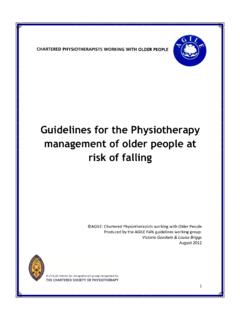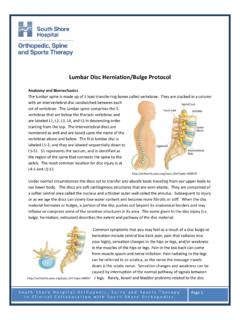Transcription of Elderly Mobility Scale (EMS)
1 Elderly Mobility Scale (EMS) Summary: Measures: Scale of assessment of Mobility . Description: The EMS is a 20 point validated assessment tool for the assessment of frail Elderly subjects (Smith 1994). The EMS is measured on an ordinal Scale . Who s it for: Older people in a hospital setting either on a ward or in a day hospital. Properties: Reliability: Inter-rater YES Validity: Predictive YES Concurrent YES Responsive to change: Not established Sensitivity: Not established Specificity: Not established Training: Minimal Equipment: Metre rule, stop watch, access to a bed and chair, and usual walking aid. Space needed: Space for bed, chair, wall, space for 6m walk. Time to complete: 15 minutes Good things about it: Functional, clinically significant, minimal training needed, can be used as an assessment tool and an outcome measure.
2 Limitations: Difficult to use in community environments, ceiling effect for more able patients, not sensitive for patients with issues of poor confidence. Version 2 Updated June 20122 Version 2 Elderly Mobility Scale - EMS Purpose To provide a Scale for assessment of Mobility , considering locomotion, balance and key position changes. The Functional Reach component as well as the whole EMS can predict an individual who is at risk of falling (Duncan et al 1992, Spilg et al 2003) Description The Elderly Mobility Scale (EMS) is a 20 point validated assessment tool for the assessment of frail Elderly subjects (Smith 1994). EMS is an ordinal Scale measurement. Appropriateness This test is appropriate for Elderly patients in a hospital setting (Prosser and Canby 1997, Smith 1994) once the acute medical condition has resolved, or as out patients in Day Hospital environment (Chiu et al 2003).
3 Theoretical Basis EMS evaluates an individual s Mobility problems through seven functional activities including bed Mobility , transfers and bodily reaction to perturbation (Chiu et al 2003). Speed of sit to stand and walking speed are analysed. Studies have shown that walking speed diminishes with age with the average walking speed of healthy women over 75 being 1 metre per second (Leiper et al 1991). Increasing frailty will reduce walking speed further. Bassey et al (1992) found that frail Elderly people often used upper limbs to assist with sit to stand and took longer to carry out the procedure. In EMS gait is assessed based on the type of assistance required to walk. The subject achieves maximum points if they walk safely with no aid or 1 stick.
4 Where a frame, rollator, 2 sticks or crutches are used the score reduces. This differentiation is important as frame and rollator users have been shown to have weaker lower limbs (in terms of leg extensor power), and poorer functional performance in terms of walking speed, stair climbing and chair raise (Bassey et al 1992). (For the theoretical basis of Functional Reach see FR details) Properties Concurrent Validity was assessed for the EMS by correlating scores with the Functional Independence Measure and Barthel Index. EMS scores correlated highly at and respectively. The EMS was also found to correlate with the Modified Rivermead Mobility Index (Spearman s rho = ) (Nolan et al 2008) Inter-rater Reliability was established by comparing results of clinical physiotherapists compared to the researcher.
5 Various grades of clinical staff were used. Results of Mann Whitney Test was 196, p= showing no significant difference between testers. Discriminant Validity was assessed by testing 20 healthy community dwelling volunteers of a similar age group. This group all scored 20/20 demonstrating the Scale discriminated between those with Mobility deficits and those with none. Predictive Validity / interpretation of results Although this was not the purpose of the original research, a trend was demonstrated. Version 2 EMS > 14 = home EMS between 10 and 14 = borderline in terms of safe Mobility and independence in activities of daily living (ADL) home with help. EMS < 10 = high level of help with Mobility and ADL Spilg et al (2003) found that the EMS score was significantly associated with an individual having had 2 or more falls.
6 Yu et al (2007) classified the EMS into Bed Mobility and Functional Mobility subscales and found that these could be used to provide Mobility profiles for people in residential care settings. The scores were found to be useful to allocate people to the most appropriate care setting. The Elderly Mobility Scale is significantly more likely to detect improvement in Mobility than either the Barthel Index or Functional Ambulation Category and the magnitude of detected improvement is significantly greater using the Elderly Mobility Scale (Spilg et al 2001) Sensitivity - not established. The original paper by Smith (1994) contained an error in the FR measurement section of the EMS. This error was replicated in Version 1 of the EMS section of the AGILE Outcome measures manual. This was corrected in Smith (1994a) and the corrected version is used and referenced in Version 2 of this manual.
7 However, it must be noted that several research papers quoted in this review use the version referenced originally, rather than the corrected version. Version 2 Patient TASK Date Lying to Sitting 2 Independent 1 Needs help of 1 person 0 Needs help of 2+ people Sitting to Lying 2 Independent 1 Needs help of 1 person 0 Needs help of 2+ people Sitting to Standing 3 Independent in under 3 seconds 2 Independent in over 3 seconds 1 Needs help of 1 person 0 Needs help of 2+ people Standing 3 Stands without support and able to reach 2 Stands without support but needs support to reach 1 Stands but needs support 0 Stands only with physical support of another person Gait 3 Independent (+ / - stick)
8 2 Independent with frame 1 Mobile with walking aid but erratic / unsafe 0 Needs physical help to walk or constant supervision Timed Walk (6 metres) 3 Under 15 seconds 2 16 30 seconds 1 Over 30 seconds 0 Unable to cover 6 metres Recorded time in seconds. Functional Reach 4 Over 20 cm. 2 10 - 20 cm. 0 Under 10 cm. Actual reach SCORES / 20 / 20 / 20 Staff Initials Scores under 10 generally these patients are dependent in Mobility manoeuvres; require help with basic ADL, such as transfers, toileting and dressing. Scores between 10 13 generally these patients are borderline in terms of safe Mobility and independence in ADL they require some help with some Mobility manoeuvres. Scores over 14 Generally these patients are able to perform Mobility manoeuvres alone and safely and are independent in basic ADL.
9 Elderly Mobility Scale SCORE Version 2 Feasibility Practicalities Comments Training Minimal as long as the standard protocol is followed. Equipment Stop watch/ metre rule/ access to a bed and chair/ usual walking aid Time taken to complete the test Approximately 15 minutes (less depending on level of expertise / proficiency of the operator) Space Space for bed and chair plus a suitable walking space to allow observation of a 6 metre walk Acceptability to Older People Good for both staff and patient as seen as very functional The following section is based mostly on the clinical experience of practitioners who are experienced in the use of the tool Uses Considered functional Has clinical and personal significance Little training necessary Tests (crudely) for both leg power and strength As both an assessment tool and outcome measure with the appropriate patients Limitations In community environments, 6 metres is not often available Functional reach distances inconsistent with original Functional Reach test Ceiling effect achieved quickly for those recovering from an acute illness / or who are more able Not a very sensitive tool for people with issues of poor confidence Ensuring Consistency of administration When new members of staff join the team, their method of conducting the test should be compared to the documented method.
10 Good practice would dictate that the correct method is demonstrated to the new staff and that experienced clinicians subsequently observe them for competency whilst conducting the test. The Consistency, particularly between different observers in administrating the test should be checked regularly. 6 Version 2 References BASSEY , FIATORONE , O NEILL , KELLY M., EVANS , LIPSITZ (1992). Leg extensor power and functional performance in very old men and women. Clinical Science; 82; 321-327 CHIU , AU-YEUNG , LO (2003). A comparison of four functional tests in discriminating fallers from non-fallers in older people. Disability and Rehabilitation; 25 (1); 45-50 DUNCAN , STUDENSKI S., CHANDLER J., PRESCOTT B (1992). Functional Reach: predictive validity in a sample of Elderly male veterans.

